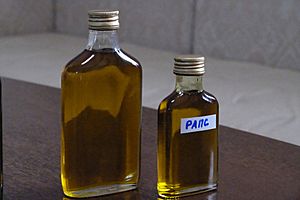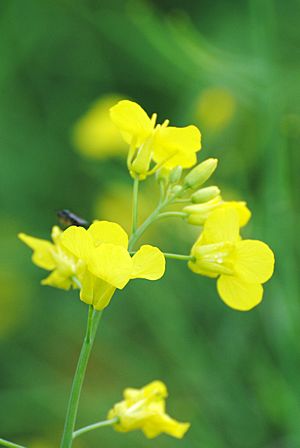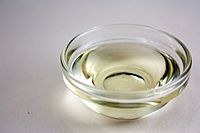Rapeseed oil facts for kids

Rapeseed oil is one of the oldest vegetable oils known to people. It comes from the seeds of a plant called rapeseed, which is part of the Brassicaceae family. You might know other plants in this family like cabbage or mustard.
Historically, people didn't eat much rapeseed oil. This was because it had high levels of something called erucic acid. This acid could be harmful to the heart of animals and made the oil taste bitter. It also contained glucosinolates, which made it less nutritious for animal feed. Rapeseed oil could have as much as 54% erucic acid.
Canola oil is a special type of rapeseed oil that is safe to eat. It comes from rapeseed plants that have been specially grown to have very low levels of erucic acid. Because it has such low levels, it's also called low erucic acid rapeseed (LEAR) oil. Governments, like in the US and EU, make sure that canola oil has no more than 2% erucic acid. This small amount is not harmful to humans.
Sometimes, non-food types of rapeseed oil are called colza oil in business.
Rapeseed is grown a lot in countries like Canada, France, the United Kingdom, and the United States. In places like France and Denmark, making oil from rapeseed is a very important industry.
Contents
History of Rapeseed and Canola Oil
Where the Name Comes From
The word "rapeseed" comes from the Latin word rapum, which means turnip. This makes sense because plants like turnip, cabbage, and mustard are all related to rapeseed. The Brassica family, which includes rapeseed, has some of the oldest oilseed plants grown by humans. People in India were using them 4,000 years ago! They were also used in China and Japan about 2,000 years ago.
In Northern Europe, people used rapeseed oil for oil lamps as early as the 13th century. The first rapeseed oil for food came out in 1956. But it had problems: it tasted strong, was greenish because of chlorophyll, and had too much erucic acid.
How Canola Was Developed
Canola was created in Canada in the early 1970s. Scientists Keith Downey and Baldur R. Stefansson at the University of Manitoba bred new rapeseed plants. These new plants had much less erucic acid and a better nutritional profile.
The name "Canola" was first a brand name. It combines "Can" from Canada and "OLA" from "Oil, low acid." Now, "canola" is a common word for edible rapeseed oil in North America and Australia. The new name helps people know it's different from older rapeseed oil, which had high erucic acid.
Genetically Modified Canola
Scientists have also used genetic engineering to make rapeseed plants even better. In 1995, a type of canola that could resist the herbicide Roundup was introduced in Canada. This means farmers can spray Roundup to kill weeds, and the canola plants stay healthy.
In 1998, a genetically modified (GM) canola was developed that was very good at resisting diseases and drought. By 2009, about 90% of the canola grown in Canada could resist herbicides. In 2005, 87% of canola in the US was genetically modified. In 2011, about 26% of all canola grown worldwide was genetically modified.
Sometimes, these GM traits can spread to wild rapeseed plants. A study in North Dakota found that many wild rapeseed plants had genes for herbicide resistance. This might happen when trucks carrying GM seeds accidentally spill them.
How Canola Oil is Made
Canola oil is made in a factory. First, the seeds are gently heated and then crushed. Most commercial canola oil is then taken out using a special liquid called hexane. This liquid is removed at the end of the process.
Finally, the canola oil is cleaned up. This involves using water and acid to remove unwanted parts. It's also filtered to make the color lighter and treated with steam to remove any strong smells. Sometimes, it's bleached to make it even lighter. Canola oil weighs about 0.92 grams per milliliter.
Some canola oil is also made by "cold-pressing" or "expeller-pressing." These methods use less heat and chemicals.
About 44% of a canola seed is oil. The rest is called canola meal, which is used to feed animals. About 23 kilograms (50 pounds) of canola seeds can make 10 liters (2.6 US gallons) of canola oil.
Canola oil is a key ingredient in many foods. People around the world want it because it's known as a healthy oil. It's the third most used vegetable oil, after soybean oil and palm oil.
Canola oil also has many uses outside of food. Like soybean oil, it can replace oils made from petroleum. It's used in things like industrial lubricants, biodiesel, candles, lipsticks, and newspaper inks.
If canola vegetable oil is certified as organic, it must come from non-GMO rapeseed plants.
Uses of Rapeseed Oil
Besides being used in food, rapeseed oil is also used as a lubricant for machines. In Europe, it was widely used for lighting homes before gas or kerosene became common. It was also the favorite oil for train lamps and for lighting railway coaches in the United Kingdom.
In lighthouses, like in early Canada, rapeseed oil was used before mineral oil was introduced. It was cheaper than whale oil and worked well with Argand burners. During the American Civil War, people in the Confederacy also burned rapeseed oil to a small extent.
Rapeseed oil was even used in a popular horse and human liniment (a type of medicine rubbed on the skin) called Gombault's Caustic Balsam around 1900.
One unusual use for rapeseed oil is to calm choppy seas. The oil changes the surface tension of the water, making the surface smoother very quickly. Because of this, ship's lifeboats used to carry rapeseed oil.
Biodiesel
Rapeseed oil can be used as diesel fuel. It can be used as biodiesel, or mixed with regular diesel fuel. Biodiesel can be used by itself in newer engines without causing damage. It's often mixed with fossil-fuel diesel in amounts from 2% to 20% biodiesel.
Making biodiesel from new rapeseed oil can be more expensive than making regular diesel. So, diesel fuels are often made from used oil instead. Rapeseed oil is a popular choice for making biodiesel in Europe. This is partly because rapeseed plants produce more oil per area of land compared to other oil sources like soybeans. Also, canola oil has a much lower gel point (meaning it stays liquid at colder temperatures) than most other vegetable oils.
A study in 2018 suggested that rapeseed might become a less reliable source for biofuels in the future due to climate change.
Other Edible Rapeseed Oils
Some countries use less-processed versions of rapeseed oil for their unique flavors. For example, in China, rapeseed oil was originally made from field mustard. In the 1800s, European traders brought rapeseed (B. rapa) to China. Local farmers mixed these new plants with field mustard to create a new type of rapeseed. This new type accidentally had lower levels of erucic acid, similar to canola.
The special flavor of Chinese rapeseed oil comes from how it's made: the seeds are toasted before the oil is pressed out. In India, mustard oil is used for cooking. In the United Kingdom and Ireland, some chefs use a "cabbagey" tasting rapeseed oil that is cold-pressed. This cold-pressed oil has a low smoke point, meaning it can't be heated to very high temperatures, so it's not good for frying in some types of cooking, like Sichuan cuisine.
Images for kids
-
Canola field in Manitoba, Canada
See also
 In Spanish: Aceite de colza para niños
In Spanish: Aceite de colza para niños





